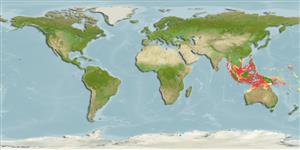Classification / Names
Common names | Synonyms | Catalog of Fishes(genus, species) | ITIS | CoL | WoRMS | Cloffa
Teleostei (teleosts) >
Perciformes/Scorpaenoidei (Scorpionfishes) >
Peristediidae (Armored searobins or armored gurnards)
Etymology: Satyrichthys: Latin, satyrus = a god or demon, partly human and partly bestial, companion of Bacchus + Greek, ichthys = fish (Ref. 45335).
More on author: Fowler.
Environment: milieu / climate zone / depth range / distribution range
Ecology
Marine; bathydemersal; depth range 0 - 507 m (Ref. 93228). Deep-water
Western Pacific: Philippines and Indonesia.
Size / Weight / Age
Maturity: Lm ? range ? - ? cm
Max length : 20.1 cm SL male/unsexed; (Ref. 93228)
Short description
Identification keys | Morphology | Morphometrics
This species is distinguished by the following characters: 2 (rarely 1) lip and no (rarely 1) chin barbels; dusky spots present along base of dorsal fin; with antrose spines on upper lateral bony plates of caudal peduncle present (rarely absent) (Ref. 93228).
Life cycle and mating behavior
Maturities | Reproduction | Spawnings | Egg(s) | Fecundities | Larvae
Kawai, T., 2013. Revision of the peristediid genus Satyrichthys (Actinopterygii: Teleostei) with the description of a new species, S. milleri sp. nov. Zootaxa 3635(4):419-438. (Ref. 93228)
IUCN Red List Status (Ref. 130435)
Threat to humans
Harmless
Human uses
Tools
Special reports
Download XML
Internet sources
Estimates based on models
Preferred temperature (Ref.
123201): 14.4 - 27.4, mean 23.3 °C (based on 183 cells).
Phylogenetic diversity index (Ref.
82804): PD
50 = 0.5078 [Uniqueness, from 0.5 = low to 2.0 = high].
Bayesian length-weight: a=0.00646 (0.00304 - 0.01372), b=3.08 (2.90 - 3.26), in cm total length, based on LWR estimates for this (Sub)family-body shape (Ref.
93245).
Trophic level (Ref.
69278): 3.5 ±0.3 se; based on size and trophs of closest relatives
Resilience (Ref.
120179): Medium, minimum population doubling time 1.4 - 4.4 years (Preliminary K or Fecundity.).
Fishing Vulnerability (Ref.
59153): Low vulnerability (15 of 100).
